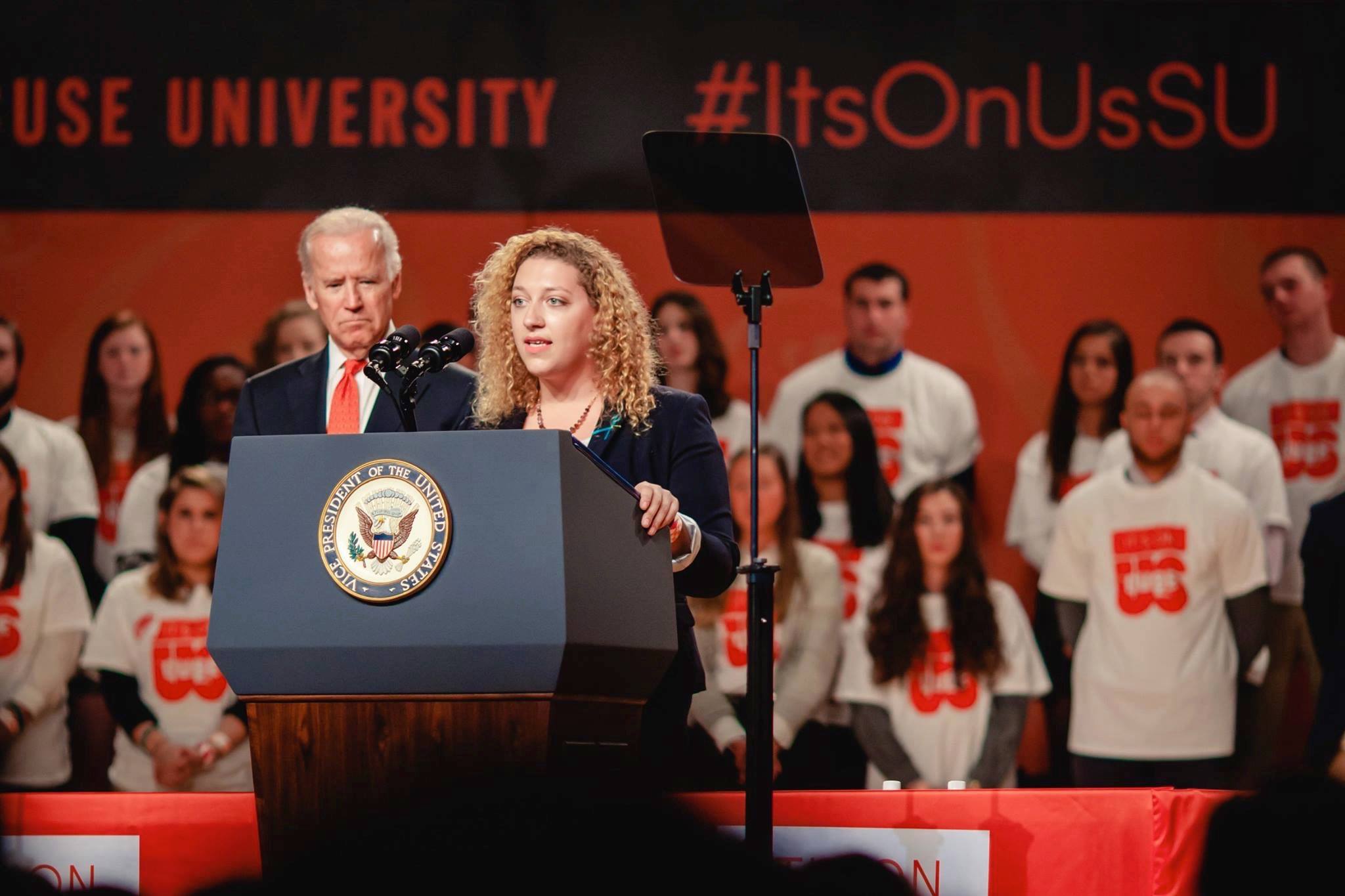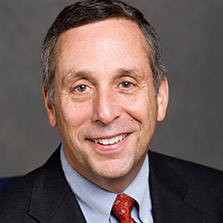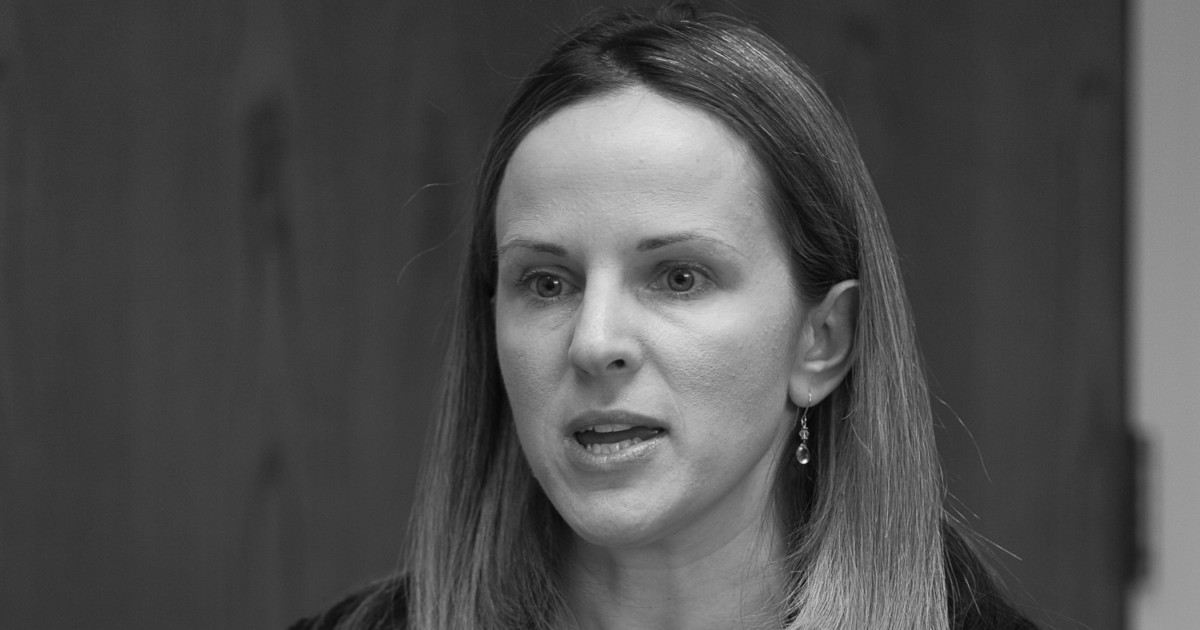Sexual violence is an issue that no college campus can ignore. But for too long, it has not received the acknowledgment or accountability it warrants. The It’s On Us campaign hopes to change that by widening the responsibility for changing the culture around sexual assault to include the whole campus community. The full slogan, “it’s on us to stop sexual assault” has an expansive definition of “us” that encompasses not only students, but professors, community leaders, parents, and administrators.
“Unfortunately, sexual assault on campus has been an issue that has been the burden of survivors alone,” said Rebecca Kaplan, the founding director of It’s On Us. “We need to lessen that burden through education, bystander intervention, and other efforts that give survivors the support they need.”
Kaplan’s perspective comes from personal experience. Her best friend was sexually assaulted during their freshman year in college. And while she remembers her suffering through victim- blaming and isolation, Kaplan was not equipped to help her in any significant way.
“When she came forward, I wasn’t educated on how to be a supportive friend and had no idea what her options were,” Kaplan said. “The education level for bystanders and friends was so different from what it is now. It was important to me to be a part of a movement that supports survivors and educates all of us on how to be a part of the solution to end sexual violence.”
Addressing sexual assault, particularly on college campuses, was one of the Obama administration’s most prominent domestic policy initiatives. In 2011, the Department of Education’s Office of Civil Rights issued the “Dear Colleague” letter, a pointed reminder that upholding Title IX requirements meant schools were responsible for responding to sexual violence on their campuses. Since then, the administration opened civil rights investigations at over 100 colleges. In January of 2014, the White House convened a task force to look into campus sexual assault and come up with recommendations to prevent it.
The resulting report emphasized the importance of engaging the whole community in the conversation to end sexual violence. It also noted that to ensure prevention, it was crucial to create a change in campus culture.
To address both, It’s On Us was created. The public awareness campaign aimed to “fundamentally shift” how the country thinks about sexual assault.
“As far as we’ve come,our society still does not sufficiently value women,” said Obama at the September 2014 campaign launch. “We still don’t condemn sexual assault as loudly as we should. We make excuses. We look the other way.”
For the one in five women and one in 16 men who are statistically projected to experience sexual violence before graduation, that loud condemnation can make coming forward about their experience a little easier.
Much of the cloudiness around sexual assault statistics stems from the fact that it is one of the least-reported crimes. A Washington Post-Kaiser Family Foundation poll found that although three-fourths of victims told someone about the assault, only 11 percent told the police or college authorities.
Reporting sexual assault is no simple task. It’s complicated by stigma and shame, fear that the police will be dismissive or worse, paralysis of action after the assault.
For survivors of sexual assault, It’s On Us sends a strong message: you are not alone.
Samantha Skaller had been assaulted the fall of her sophomore year at Syracuse University, before leaving for a spring semester abroad in France, but did not report the assault at the time. While she was away, a friend reached out and shared that she had also been sexually assaulted. Over the course of the conversation, they realized they had been raped by the same person, and that he had sexually assaulted two other mutual friends.
“I decided enough was enough,” Skaller said. She reported him the next day.
But her brave action did not end the way she had hoped. The investigation was over by the time she was back on campus for the fall of her junior year. Her case was dismissed, with all charges dropped.
Fueled by the decision, Skaller was determined to advocate around sexual assault prevention. She was unsure where to start when she came across an application for It’s On Us Student Advisory Committee, one of the pillars of the It’s on Us campaign.
In October of 2015, Skaller became one of the 17 inaugural committee members. Her appointment led to two years of strong activism on Syracuse’s campus. She spoke to every student organization about sexual assault prevention, including nontraditional partners, like athletics teams and fraternity houses, reaching students who might not seek education on their own. She gave presentations an average of 10 times a week during her upperclassman years at Syracuse.
“It’s On Us completely changed my life,” Skaller, now a graduate student at McGill University, said. “It gave me a voice when I didn’t think I deserved a voice.”
*
It’s On Us originally consisted of highly produced videos and a call to action to sign a pledge online, committing to being a part of the solution. Organizations with national media reach like the NCAA and Viacom Media, whose television network includes MTV, BET, and CMT, signed on as partners for the launch. Nearly 200 university student body presidents also supported the organization from the beginning. Through these partnerships, the first PSA videos reached audiences through televised college sports events, MTV spot ads, and campus events. The original Hollywood headliners and White House backing would later help students get campaigns off the ground on their own campuses.
In the video that kicked off the campaign, celebrities including Kerry Washington, Jon Hamm, and Common face the camera head-on wearing It’s On Us t-shirts and hoodies. They take turns finishing each other’s sentences: “It’s on us” “to get in the way before it happens.” “It’s on us” “to not blame the victim.”
Former Vice President Biden and former President Obama appear at the end of the video. Biden says “It’s on us, all of us, to stop sexual assault.” Obama encourages viewers to “learn how and take the pledge at It’sOnUs.org.”
The pledge has four parts:
1. To recognize that non-consensual sex is sexual assault.
2. To identify situations in which sexual assault may occur.
3. To intervene in situations where consent has not or cannot be given.
4. To create an environment in which sexual assault is unacceptable and survivors are supported.
To date, over 440,000 people have signed the pledge, adding their names to a list of supporters who see themselves as part of the solution to end sexual assault.
Skaller said she used the pledge as the first action step anyone at a presentation could take. She would end her events by asking people to pull out their phones and take the pledge.
“Sometimes talking about sexual assault can leave you feeling helpless,” she said. “But I want people to feel inspired to take action. People from every identity, every community have the ability to take the pledge to change the culture they’re in and the campus they’re on.”
The pledge, operatively, doesn’t include specific action items. The open structure of the national organization allowed student voices to take the It’s On Us mission and national recognition and apply it to their own campuses. It built a network of student voices creating change from the ground up.
“They recognize that every institution and every culture is different,” Skaller said. “By being general at the national level, it allows students to use own talents.”
Now, over 500 campus chapters across the country host events and advocate for policy change, as well as encourage their student bodies to sign the pledge and be a part of the solution. The national chapters of some fraternities and sororities have become It’s On Us partner organizations. For many campus chapters, the pledge serves as the springboard for a conversation, a structured way to approach sexual assault with the backing of a national organization.
Rachel Gerstenfeld, currently a junior psychology major at the University of Washington, founded her school’s chapter of It’s On Us. She is now in her second year working with It’s On Us as a member of the Student Advisory Committee.
Last year, she created a presentation that took the four main tenets of the national campaign’s pledge, then added specific bullet points underneath each that were specific to UW resources. Along with her team of volunteers from different campus communities, she gave the presentation to student groups that make up the campus’s social patchwork, from ROTC to international students to sororities.
“Sexual violence affects every community,” she said. “It was important to me and my team that we don’t leave anyone out of the conversation.”
The campaign allowed them to reach staff and senior administration, all the way up to the university president, Ana Mari Cauce. They are now working with the Associate Vice President of Student Life and the school’s Title IX coordinator to get more student input on sexual assault policies on campus.
“There are lots of single days, single nights to raise awareness for sexual assault,” Gerstenfeld said. “But I wanted to start a movement that would last for years to come.”
Gerstenfeld believes that the campaign’s empowering tone helped them build healthy relationships with the administration.
“Even though it’s a frustrating, tough problem, we wanted it to be about working together,” she said.
*
As the national It’s On Us campaign continues to grow beyond the original PSA videos and pledge, It’s On Us recently hired Elvin Bruno, Jr. as Campus Program Director to bring the organization closer to students who have been working on the campaign on the ground. Bruno’s background is in campus political organizing, and as a recent college graduate himself, he is passionate about working to empower young people on campus.
This year, seven student Regional Advisors will guide the 105-member Student Advisory Committee, the organization’s biggest yet. The advisory committee will, in turn, share goals with the nearly 250 Campus Organizers, representing 44 states and the District of Columbia.
On a recent organizing call, Bruno addressed hundreds of It’s On Us student leaders.
“Looking at the year ahead, I’m most excited to see where you take this organization and how much you grow,” he told the students. “It’s On Us is gearing up to celebrate our third anniversary, and we have a chance to write a new chapter for the organization.”
That new chapter is focusing on a stronger structure with more specific directions coming from the national offices. For the first time, every campus chapter will have five core team members with specific, dedicated responsibilities, such as active bystander training and survivor resources.
The kickoff call gave an overview of specific action items — for team member recruitment, for upcoming anniversary events, for social media campaigns. Bruno’s goal is to use his organizing experience to help all It’s On Us campus chapters become more than just a visibility campaign.
“The pledge is incredible,” Bruno said. “We still want it to be the flagship, but now it’s just the first step of a college student getting involved. We want to take the people who sign the pledge and make them action-takers.”
The new chapter also comes at an inflection point for sexual assault activism.
Education Secretary Betsy DeVos recently rescinded the Obama-era Title IX guidelines, stating that colleges need more freedom to account for the rights of accused students. She plans to enact new rules after a public comment period. Advocates fear that in new version will shift protections away from victim-survivors and toward students accused of sexual assault.
While the It’s On Us student leaders are still processing what the impending changes may be, they aren’t cowed.
“Regardless of political climate, this type of advocacy is here to stay,” Skaller said. “No matter what happens with Title IX, no matter what happens politically, the students are the leaders of this. And we aren’t going anywhere.”




